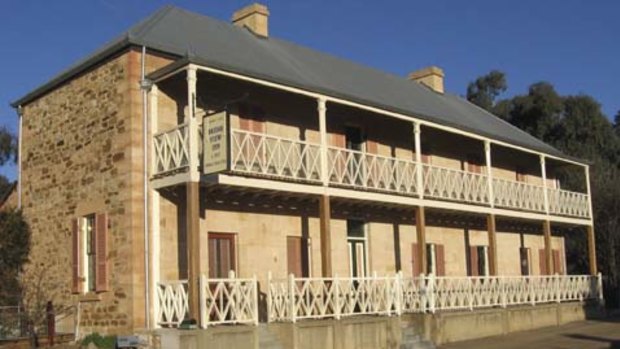This was published 9 years ago
Rylstone, New South Wales: Travel guide and things to do

Bridge View Inn, Rylstone.
Rylstone is an old stone village of about 1200 people on the Cudgegong River. It is located 237 km north-west of Sydney, 47 km south-east of Mudgee, 93 km north of Lithgow and 590 m above sea-level. Wool, sheep, cattle, coalmining, wine, olives, tourism and cement production are the mainstays of the local economy.
The area was occupied by the Wiradjuri people prior to white settlement. A townsite was surveyed in 1842 at what had been a camping spot for stockmen. St James Anglican Church was founded in 1850. Notorious bushranger Captain Thunderbolt was once held at the lock-up overnight in 1861 while being transported to Bathurst to stand trial for horse theft.
Things to see
Tourist Information
Tourist information is available from the Bridge Service Station, Kandos tel: (02) 6379 4004.
A visitors guide is available from retail outlest with Rylstone and Kandos.
The district offers a number of other attractions for the visitor besides sport, bush walking and scenic vehicle trips.
Heritage Buildings
The town has many fine old stone buildings, especially in Louee St. A Heritage Trail pamphlet is available from the information centre and from the box outside the courthouse.
A few buildings of note are the Bridge View Inn, the Globe Hotel, the post office, the police station, the courthouse and the shire hall. The old town granary was built in the early 1840s and Henry Lawson's father helped to build the fine timber railway station (1884).
Tindale Park Reserve
Tindale Park Reserve, on the river's banks, makes for a pleasant picnic, barbecue and swimming spot. Platypus can sometimes be seen in the waters here and in the river below the showground. It can be found at the end of Cox St.
Dunns Swamp
Dunns Swamp is located within Wollemi National Park. It was formed by the trapped water of Kandos Weir, established in the 1920s when the Cudgegong River was dammed to provide water for the Kandos cement works. It is an ideal spot for bushwalking, camping, canoeing, swimming, li-loing, birdwatching, fishing and picnicking. To get there head due east and then turn left on to the Narrango Rd. En route you will see, to the immediate east, Mt Coricudgy (1255 m above sea-level).After about 25 km turn left into Dunns Swamp Access Rd which leads to a picnic and camping area.
From this point there is a short wheelchair-friendly walking track which leads to an Aboriginal site that features hand stencils which may be as much as 7000 years old. Numerous other less distinct walking tracks surround the lagoon (as outlined on a National Parks and Wildlife Service brochure relating to the swamp).
The flora and fauna is plentiful, including platypuses and kangaroos, and the incredible formations known locally as 'pagodas' which provide excellent views of the park.
Sites cannot be booked. There are barbecues with wood supplied. There are composting toilets but no showers or drinking water (if you are using dam water boil it first). For further information ring the National Parks office at Mudgee, tel: (02) 6372 7199.
Wollemi National Park
Wollemi National Park is the second-largest national park in New South Wales, covering 487 500 hectares. It is the home of the Wollemi Pine. This 'living fossil', first discovered in 1994, is the closest surviving relative of species which date back 150 million years.
As the park is situated on a soft sandstone base, erosion has created substantial valleys and precipitous escarpments. The terrain is rugged and there are few access points or trails, so access can be problematic but, for those willing to make the effort, this remote wilderness offers substantial rewards. The variety of land formations gives rise to a range of flora types, including swamp, heath, woodland and patches of rainforest. The fauna includes wombats, kangaroos, wallabies, wallaroos, koalas and rare species such as the glossy black cockatoo and the broad-headed snake.
The park offers abseiling, canyoning or treking to numerous mountain peaks. Limited access is available to 4WD vehicles. For more information ring (02) 6372 7199.
Windamere Dam
Windamere Dam, on the Cudgegong River, is located about 19 km south-west of Rylstone. It was completed in 1984 to meet irrigation, stock and domestic demands. The main drawcard for recreation seekers is the fishing, though sailing and waterskiing are also popular.
Cudgegong Waters Park, located just off the Mudgee Rd at the southern end of the dam, has cabins, campsites, barbecue areas, on-site caravans, a concrete boat ramp and a kiosk selling bait, lures, ice, groceries and petrol.
There are plentiful stocks of golden and silver perch, with lesser numbers of Murray cod and catfish. The numerous fishing spots are outlined in a brochure about the dam which is available at Cudgegong Park or at the Mudgee Visitors' Centre.
To get there from Rylstone take the road south-west out of town, keep to the right and you will see Cudgegong Park on your right a little before you reach the Mudgee Rd. For further information ring (02) 6358 8462.
Fern Tree Gully
Fern Tree Gully is a highly scenic rainforest area to the north of town which has been furnished with walkways and lookouts. To get there head north of town on the Bylong Valley Way (towards Bylong and Muswellbrook) past the airport and down to the valley where the surfaced road ends. About 16 km from Rylstone take the signposted turnoff to the right at the old stone house. For further information ring (02) 6372 7199.
Sign up for the Traveller Deals newsletter
Get exclusive travel deals delivered straight to your inbox. Sign up now.